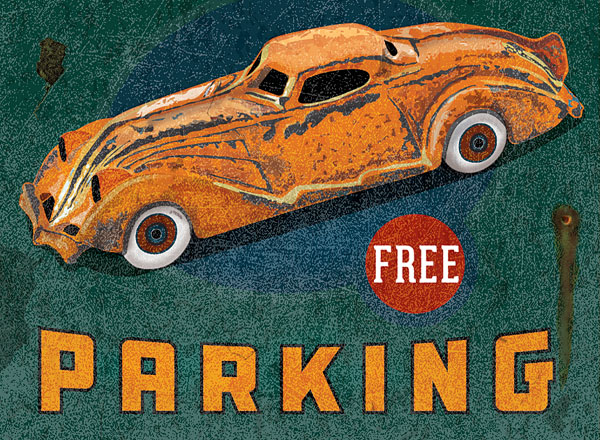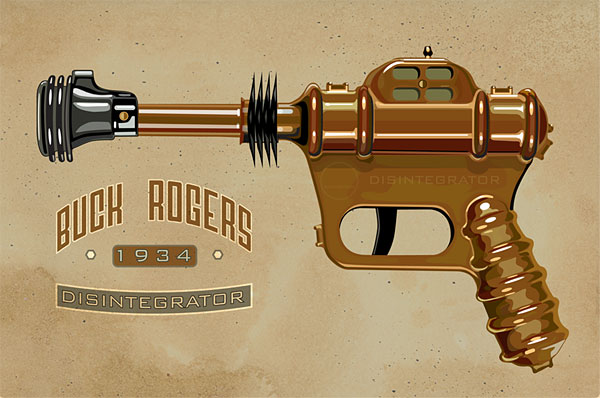One Minute With…
David Cran

Hi David, thanks for taking time to chat with One Minute With. Tell us a little bit about yourself and your work.
Thanks Conor, I am glad you like my work. I was born in Australia, too late to be a baby boomer, but too early to be of Generation X. I did however go to The Emily Carr School of Art And Design in Vancouver with Douglas Coupland who coined “Generation X”.
I have lived and worked in Australia, New Zealand, USA and Canada. Growing up in Australia in the 1960’s was like growing up in the 1930’s in North America. In Queensland they did not even have daylight savings time because they feared that their curtains would fade from the extra hour of daylight.
In the schools, we used desks that had actual ink wells in the corner and this was when I first started to draw with a fountain pen. When I got bored I would put the hair of the girl in the desk in front of me in the inkwell and watch the capillary action.
Once, as a boy, my Grandmother had a fortune teller read my tea leaves and she told me that I would work with computers when I grew up. This was very puzzling to me and I pictured myself dusting off my white lab coat and loading a reel of tape on to some giant machine.
My first exposure to computers came in 1978 when I graduated from Mercer Island High School in Seattle and a friend had an Apple II. At that same high school I was diagnosed as artistic by an incredible art teacher, Ron Adams who told me that some people actually got paid to make images. Later in art school I had a Commodore PET, then an Amiga and a short while later the first Macintosh.
My style has been labeled nostalgic, retro and vintage, but my influences simply come from the graphic images and pop art that I grew up with. I specialize in logos, branding, screen printing and illustration.
I am half Irish and half Scottish, so I like to drink, but I don’t like to pay for it.
Walk us through a typical day in the life of David Cran.
I get up early no matter what. I read the newspapers online from every town I have ever lived in. I go on Dribbble and Flickr. I read my e-mails, but I never answer them in the morning. I make myself an espresso on my 1963 Atomic stove top coffee maker.
Then If I am in Vancouver I walk one of the numerous trails without a cell phone. This is when I start planning how to draw the ideas that have come to me during the last night’s sleep. If I am in Seattle I visit Bruce Lee’s grave and then go canoeing in the arboretum.
I then return to my home studio and hit the computer. I listen to music all day.
My wife or my son Riley will occasionally stop by to critique my latest creation, Riley being a full captain with the Kerning Cops.

How did you get into design? Was there a defining point in your career, and if so, how did it shape you as a designer?
Although I had always had a fascination with logos and branding, I went to art school to major in photography and film making. The darkroom was located next to the graphics department, but that area was considered off limits to any self respecting fine artist. Graphics was for geeks with sheets of Letraset, but I soon noticed that all the hottest girls in the school took typography.
One day while I was waiting for my film to develop I wandered downstairs into the printmaking department and I liked it so much that I never left. Screen printing then became my obsession, which would later lead me to create colour separation software called Screenprint Separator and then inkjet film positives. After art school I married one of the girls from typography and I needed to make money, so I founded one of Vancouver’s first t-shirt printing companies. We made everything by hand until I borrowed some funds from a client and bought my first Mac with a laser printer. Business took off and we were soon printing 80 percent of the shirts sold at Whistler and Blackcomb mountains.
Then my friends from art school who were by now working in Vancouver’s burgeoning film industry started asking me to design and print props. In those days there were no colour printers, so we screen printed everything like signs, newspapers and fake cereal boxes for use on TV shows and movies.
The demand for movie props drove me to draw my own fonts, because in the early days there were only about 10 fonts for the computer, 3 of them were “clown heavy”, “barf bold” and “Helvetica”. Soon I was designing fake logos for television episodes of Wiseguy and 21 Jumpstreet where I met a wonderful guy named Johnny (Depp).
This led me to doing real logos and business boomed. Soon I bought one of the first colour computers, the Macintosh II with a blazing 12 megahertz and a massive 40 megabyte hard drive. I used to load that beast into my car and drive it home every night so I could continue working.

How do you approach a new project? What’s your creative process like?
That is a tricky question. Sometimes an idea comes quickly from out of the ether. Sometimes I have to think for a week. I always thought that as I got older, the good ideas would be harder to find, but this has not turned out to be the case.
I rarely look at other logos for inspiration. Digital photography has proven useful for Illustration. When I draw in vector, I often start from a blank page and start experimenting until I have something interesting.
Then I make numerous corrections until it looks right. I listen to my customer. I think about of my customer’s customer.
You have to be willing to scrap some work no matter how much time it took.

Your son, Riley, is also a graphic designer, and a fantastic one at that. How important was it, to you, to pass on the torch to the new generation? Do you ever hope/fear that he will one day surpass you?
I raised Riley to be an artist. Music was a big part of that. Its something that we have in common in a huge way. He can really play the guitar and I thought that he might become a professional musician. Now, he has entered the graphics world. I could not be more proud of his work and great success. Certainly the Lost Type Co-op has become a web phenomenon.
He has already surpassed me in many ways, and that is why I had a son in the first place.
I came from a family of accountants, writers, lawyers and soldiers so I am happy to see Riley continue with my graphic heritage.When I told my Dad that I was going to art school, he said in his heavy Australian accent “Is there any dancing at this school, son?”

You’ve had a long and illustrious career spanning over 30 years. Having seen dozens of trends come and go, and new technologies change the industry, where do you see the design industry going in the next, say, 5 or 10 years?
For the first decade I worked on a computer that was not even hooked up to the internet. My first scanner was black and white. My first copy of Photoshop was given to me by Adobe on a floppy disk. We used to add texture by taping prints from the laser printer to the road outside the studio and waiting until after rush hour to retrieve them.
During all of that, I thought, “Wow, this is great!” I would wish for a few special tool additions to Illustrator, but I really could not imagine the changes that we see now.
The way we can send what we make over the net has created a whole new community that never existed before. This connection will continue to strengthen graphic design as a career – we can now work globally.
I feel that Illustrator and Photoshop have about all the features that anyone would need. The next big drive should be a massive change to how user friendly graphics software is. I can’t imagine learning Illustrator and Photoshop from scratch today. It might be easier to learn the operations manual of a Trident submarine.
If, in some Freaky Friday-like situation, you could live the life of another designer, illustrator or creative, for a day, who would it be, and why?
I would be a designer at Guigario or Carrozzeria Ghia SpA. I have a passion for vintage cars and most weekends you can find me covered in grease with a small gash on my forehead.

What design tools could you not live without?
Well, I tried running Photoshop on an abacus once with no results, so I could not carry on without a Mac.
Digital camera, Dribbble and Flickr. Chardonnay. My assistant mouse-riding lovebird named Apple.
Oxygen.
And finally, what tips would you give to anybody who is looking to get started in design?
This life is not for idle types or wimps.
Graphic design can be cruel.
Work your ass off, but be polite, even when you are tired and crabby.
Don’t build a giant ego.
Don’t copy other designer’s work – they will find you.
Never answer e-mails first thing in the Morning (think about it first).
Don’t use Helvetica.
Above all, consider yourself lucky to have this job, keep your sense of humour and don’t sit for long periods.
Stay out of Portland.
2 Comments
Ron Adams
I am the art teacher that told David that ” you could get paid for making images “. I have watched him through the ups and downs of his career. He is still an incredibly creative artist. A true inventor and creative tinkerer . He is durable and thoughtful. I love his work and wish he lived closer so I could buy him a drink. I always look froward to seeing his next design.
Adam Farwell
Very interesting and insightful article to the history of design careers. I’m a young designer who hopes for as much excitement and growth in my life as David had!